 |
 |
 |
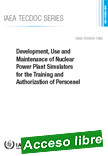 |
Development, Use and Maintenance of Nuclear Power Plant Simulators for the Training and Authorization of Personnel
IAEA ¦ TECDOC-1963 ¦ Date published: 2021 ¦ 180 pages
The use of simulators for the training and qualification of nuclear power plant (NPP) control room operating personnel has become a standard practice throughout the world to develop and reinforce knowledge of plant systems and their relationships. It is an approach to increase the ability to apply plant procedures, to advance practical skills in operating the plant in normal, abnormal and emergency conditions, and to build supervisory skills and teamwork.
|
Simulators are also utilized to conduct the authorization or licensing examinations of control room operating personnel, and there is an increasing trend in the use of simulators for non-training purposes. This publication provides Member States with comprehensive guidance on NPP operator training and describes the use of simulators in training and qualification programmes for the personnel. Current trends in the use of simulators in training programmes, as well as approaches to maintaining and upgrading simulators, are also presented.
|
 |
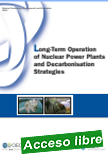 |
Long-Term Operation of Nuclear Power Plants and Decarbonisation Strategies
OECD - Nuclear Energy Agency ¦ NEA No. 7524 ¦ 2021 ¦ 155 pages
The existing nuclear fleet remains the largest low-carbon source of electricity generation in OECD countries. In 2021 the average nuclear power plant had already been operating for 31 years and some 30% of reactors worldwide were already operating under long-term operation conditions. The long-term operation of this existing nuclear capacity will be essential over the next decade to keep decarbonisation targets within reach.
|
At the same time, by keeping the long-term-operation option open, countries could also reap a wide-range of socio-economic benefits including more affordable and secure electricity supply. Nevertheless, an increasing number of reactors are being shut down earlier than expected due to policy decisions and increasing market pressures in some regions. In light of these trends, this study takes a holistic approach to identifying the key enablers for long-term operation of nuclear power plants. The attractiveness of long-term operation lies in its technical maturity, cost-competiveness and ease of implementation: it is a high-value option to support the energy transition while minimising potential risks along the way.
|
 |
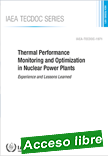 |
Thermal Performance Monitoring and Optimization in Nuclear Power Plants: Experience and Lessons Learned
IAEA ¦ TECDOC-1971 ¦ Date published: 2021 ¦ 220 pages
The objective of the publication is to provide the best practices and practical experiences related to the monitoring and optimization of plant thermal performance to enhance efficiency and reliability. All the methods available including those described in this publication are to be considered estimates. The publication describes the essential elements of a thermal performance programme, providing guidelines on the design of the BOP systems for new build NPPs and improvements to an existing programme for operating NPPs.
|
It focuses on the roles and responsibilities of a thermal performance engineers (TPEs) and their interface with other site organizations. This publication is intended for NPPs owner operators, engineers and specialists to maintain and improve thermal system efficiency.
|
 |
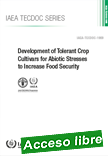 |
Development of Tolerant Crop Cultivars for Abiotic Stresses to Increase Food Security
IAEA ¦ TECDOC-1969 ¦ Date published: 2021 ¦ 44 pages
Salt stress is the second most widespread soil problem after drought in arable crop production worldwide. Excess salt in soil adversely affects plant growth, development, and productivity when osmotic stress reduces water uptake by roots. This publication provides standard operating procedures for managing crop phenotyping in controlled/semi-controlled environments and natural field conditions.
|
As a comprehensive reference, the publication will support IAEA Member States in the application of these procedures to increase the productivity of arable food crops to help withstand the impact of climate change on agriculture.
|
 |
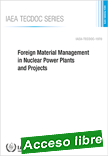 |
Foreign Material Management in Nuclear Power Plants and Projects
IAEA ¦ TECDOC-1970 ¦ Date published: 2021 ¦ 224 pages
This publication aims to address all relevant aspects and principles of an effective and continuously improving the programme for FMM (hereafter FMM Programme or FMMP) throughout the entire lifecycle of a nuclear power plant, specifically focusing on: Foreign material management system, culture and responsibilities; Foreign material control; Foreign material intrusion event prevention and protection; Foreign material intrusion event mitigation, including search, detection, retrieval, recovery, analysis, assessments and evaluation activities.
|
This publication, therefore, intends to provide a set of descriptive and practiced processes that integrate safety, performance and economical aspects for reliable and efficient operation of nuclear power plants with minimisation or elimination of FMI events. As such, this publication is primarily to assist organisations and persons involved in the FMMP preparation and establishment or in its application and maintenance, including: Nuclear power project and future owner/operating organisations in the Member States, who are purchasing and building new nuclear units, i.e. those entities establishing new FMMPs; Nuclear power plant owner/operating organisations (utilities), i.e. who are currently operating and continuously improving their existing ‘FME’/FMM programmes, including those that are transitioning from operation to decommissioning.
|
 |
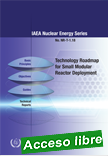 |
Technology Roadmap for Small Modular Reactor Deployment
IAEA ¦ STI/PUB/1944 ¦ Date published: 2021 ¦ 109 pages
Technology Roadmap for Small Modular Reactor Deployment Given the increasing interest of Member States in the near term deployment of SMRs, the objective of this publication is to present several model technology roadmaps to Member States which can be adapted to their specific projects. These roadmaps are based on the best ideas generated during a series of international meetings on this topic. For nuclear newcomer countries, these roadmaps assume that a Member State has already developed, or is at least well along the way in developing, the infrastructure necessary to operate a nuclear power programme.
|
The scope of the technology roadmap described in this report is the deployment of SMRs of all major types for electricity production and non-electric applications, and their integration with other energy resources. The emphasis here is on the activities of owners/operating organizations, who drive the demand and requirements for reactor designs; designers, who develop the technologies; and regulators, who establish and maintain the regulatory requirements that need to be met by owners/operating organizations. This report also provides a methodology for developing a technology roadmap for reactors with longer development horizons, and provides information on emerging opportunities and challenges for this relatively new technology.
|
 |
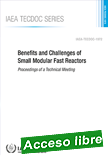 |
Benefits and Challenges of Small Modular Fast Reactors
IAEA ¦ TECDOC-1972 ¦ Date published: 2021 ¦ 360 pages
In the world market of power-producing nuclear reactors, there is growing interest towards the so-called small and medium sized or modular reactors (SMRs). These reactors size is no larger than 300 MW(e); they can be assembled in workshop (in-factory construction), transported by ship or train, installed on site and connected to the electricity grid in a short time, significantly reducing the financial burden of the investment. Interest in SMRs is particularly strong in the European Union and the United States, Russia, Japan and Korea. The first studies on SMR date back to the late 1980s and were mainly related to the light water cycles.
|
Today, the various technologies of fast reactors have also undergone an improvement, so it seems plausible to conduct a critical overview even on the different concepts of Fast SMRs. It is meant to be noted that fast reactors offer the opportunity, thanks to breeding, to achieve very long production time before refuelling, making these machines very similar to “nuclear batteries”. The objective of the present TECDOC is therefore to highlight and deepen the technological, economic and safety potential of Fast SMRs as well as the still open challenges that needs to be overcome in order to achieve sufficient credibility for market entry. The TECDOC also provides to the Member States a reference document, summarizing the work presented, including the full contribution, by the meeting participants.
|
 |
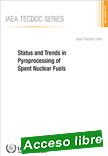 |
Status and Trends in Pyroprocessing of Spent Nuclear Fuels
IAEA ¦ TECDOC-1967 ¦ Date published: 2021 ¦ 148 pages
The importance of recycling the spent nuclear fuel through partitioning processes has been recognized worldwide for increasing and sustaining nuclear energy. Therefore, the development of advanced partitioning processes, based either on hydrometallurgical or on pyrometallurgical technologies, has received an increasing interest in recent years. Moving towards industrial demonstration, partitioning processes are applied for the separation of actinides, including minor actinides, not only to reduce the burden of high level waste to be disposed of, in terms of heat-load and radiotoxicity, but also to improve the efficiency of the resources’ utilization.
|
Furthermore, in the case of Molten Salt Reactors, whose fuel cycle is primary based on pyrochemical processes, there is a need for strengthening pyrometallurgical technologies. This publication reviews the status and trends in the development of pyrometallurgical processes and technologies for processing spent nuclear fuel and identifies gap areas requiring further development.
|
 |
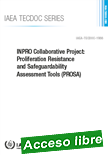 |
INPRO Collaborative Project: Proliferation Resistance and Safeguardability Assessment Tools (PROSA)
IAEA ¦ TECDOC-1966 ¦ Date published: 2021 ¦ 106 pages
This publication presents the results of the INPRO collaborative project: Proliferation Resistance and Safeguardability Assessment (PROSA) Tools. The PROSA assessment process has been developed to specifically address the needs of national self-assessors performing an INPRO Nuclear Energy System Assessment of sustainability. The main objective of this project is to explore approaches to make the INPRO sustainability assessment of proliferation resistance simpler and easier to understand.
|
In addition to lessons learned, the publication includes the results after applying the PROSA assessment to an illustrative case, demonstrating use of the refined methodology. The outcome of this project may also serve as a basis for a future revision of the INPRO methodology manual in the area of proliferation resistance.
|
 |
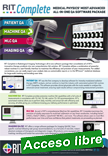 |
Report of AAPM Task Group 219 on independent calculation-based dose/MU verification for IMRT
Timothy C. Zhu, Sotiris Stathakis, Jennifer R. Clark, Wenzheng Feng, et al. American Association of Physicists in Medicine. AAPM Scientific Report, First published: 02 July 2021. 22 p.
Independent verification of the dose per monitor unit (MU) to deliver the prescribed dose to a patient has been a mainstay of radiation oncology quality assurance (QA). We discuss the role of secondary dose/MU calculation programs as part of a comprehensive QA program.
|
This report provides guidelines on calculation-based dose/MU verification for intensity modulated radiation therapy (IMRT) or volumetric modulated arc therapy (VMAT) provided by various modalities. We provide a review of various algorithms for “independent/second check” of monitor unit calculations for IMRT/VMAT. The report makes recommendations on the clinical implementation of secondary dose/MU calculation programs; on commissioning and acceptance of various commercially available secondary dose/MU calculation programs; on benchmark QA and periodic QA; and on clinically reasonable action levels for agreement of secondary dose/MU calculation programs.
|
 |
| |
|
|

|
|
|
| |
|
|
| |
| |
|
|
| |
| |
|
|
| |
| |
|
|
|
| |
| |
